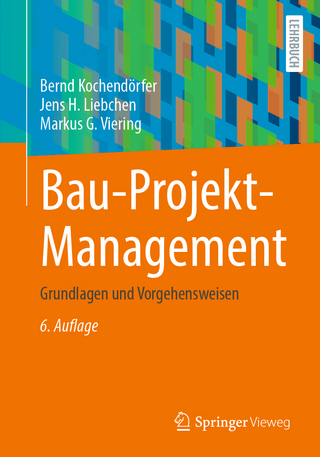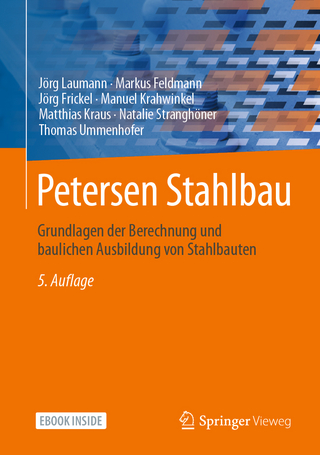
Building Control with Passive Dampers
John Wiley & Sons Inc (Verlag)
978-0-470-82491-7 (ISBN)
- Lieferbar (Termin unbekannt)
- Versandkostenfrei innerhalb Deutschlands
- Auch auf Rechnung
- Verfügbarkeit in der Filiale vor Ort prüfen
- Artikel merken
The recent introduction of active and passive structural control methods has given structural designers powerful tools for performance-based design. However, structural engineers often lack the tools for the optimal selection and placement of such systems. In Building Control with Passive Dampers , Takewaki brings together most the reliable, state-of-the-art methods in practice around the world, arming readers with a real sense of how to address optimal selection and placement of passive control systems.
The first book on optimal design, sizing, and location selection of passive dampers
Combines theory and practical applications
Describes step-by-step how to obtain optimal damper size and placement
Covers the state-of-the-art in optimal design of passive control
Integrates the most reliable techniques in the top literature and used in practice worldwide
Written by a recognized expert in the area
MATLAB code examples available from the book’s Companion Website
This book is essential for post-graduate students, researchers, and design consultants involved in building control. Professional engineers and advanced undergraduates interested in seismic design, as well as mechanical engineers looking for vibration damping techniques, will also find this book a helpful reference.
Code examples available at www.wiley.com/go/takewaki
Izuru Takewaki is a Professor of Urban and Environmental Engineering at Kyoto University and Associate Dean of the Graduate School of Engineering. His research interests include seismic resistant design of building structures, soil-structure interaction, systematization of structural design process, system identification & health monitoring, surface ground analysis, and inverse problems in vibration. He has won awards from the Architectural Institute of Japan in 1990 and 2004 for research related to earthquake-response in structures and design methods using inverse problem approaches. Takewaki is an active member of numerous civil engineering and earthquake engineering societies and journal review boards, and has held visiting appointments at Cambridge, UC Berkley and San Diego. Takewaki holds a Bachelors, Masters, and Ph D degrees in Engineering from Kyoto University.
Preface. 1 Introduction.
1.1 Background and Review.
1.2 Fundamentals of Passive-damper Installation.
1.3 Organization of This Book.
References.
2 Optimality Criteria-based Design: Single Criterion in Terms of Transfer Function.
2.1 Introduction.
2.2 Incremental Inverse Problem: Simple Example.
2.3 Incremental Inverse Problem: General Formulation.
2.4 Numerical Examples I.
2.5 Optimality Criteria-based Design of Dampers: Simple Example.
2.6 Optimality Criteria-based Design of Dampers: General Formulation.
2.7 Numerical Examples II.
2.8 Comparison with Other Methods.
2.9 Summary.
Appendix 2.A.
References.
3 Optimality Criteria-based Design: Multiple Criteria in Terms of Seismic Responses.
3.1 Introduction.
3.2 Illustrative Example.
3.3 General Problem.
3.4 Optimality Criteria.
3.5 Solution Algorithm.
3.6 Numerical Examples.
3.7 Summary.
References.
4 Optimal Sensitivity-based Design of Dampers in Moment-resisting Frames.
4.1 Introduction.
4.2 Viscous-type Modeling of Damper Systems.
4.3 Problem of Optimal Damper Placement and Optimality Criteria (Viscous-type Modeling).
4.4 Solution Algorithm (Viscous-type Modeling).
4.5 Numerical Examples I (Viscous-type Modeling).
4.6 Maxwell-type Modeling of Damper Systems.
4.7 Problem of Optimal Damper Placement and Optimality Criteria (Maxwell-type Modeling).
4.8 Solution Algorithm (Maxwell-type Modeling).
4.9 Numerical Examples II (Maxwell-type Modeling).
4.10 Nonmonotonic Sensitivity Case.
4.11 Summary.
Appendix 4.A.
References.
5 Optimal Sensitivity-based Design of Dampers in Three-dimensional Buildings.
5.1 Introduction.
5.2 Problem of Optimal Damper Placement.
5.3 Optimality Criteria and Solution Algorithm.
5.4 Nonmonotonic Path with Respect to Damper Level.
5.5 Numerical Examples.
5.6 Summary.
References.
6 Optimal Sensitivity-based Design of Dampers in Shear Buildings on Surface Ground under Earthquake Loading.
6.1 Introduction.
6.2 Building and Ground Model.
6.3 Seismic Response.
6.4 Problem of Optimal Damper Placement and Optimality Criteria.
6.5 Solution Algorithm.
6.6 Numerical Examples.
6.7 Summary.
Appendix 6.A.
Appendix 6.B.
References.
7 Optimal Sensitivity-based Design of Dampers in Bending-shear Buildings on Surface Ground under Earthquake Loading.
7.1 Introduction.
7.2 Building and Ground Model.
7.3 Equations of Motion in Ground.
7.4 Equations of Motion in Building and Seismic Response.
7.5 Problem of Optimal Damper Placement and Optimality Criteria.
7.6 Solution Algorithm.
7.7 Numerical Examples.
7.8 Summary.
Appendix 7.A.
Appendix 7.B.
References.
8 Optimal Sensitivity-based Design of Dampers in Shear Buildings with TMDs on Surface Ground under Earthquake Loading.
8.1 Introduction.
8.2 Building with a TMD and Ground Model.
8.3 Equations of Motion and Seismic Response.
8.4 Problem of Optimal Damper Placement and Optimality Criteria.
8.5 Solution Algorithm.
8.6 Numerical Examples.
8.7 Whole Model and Decomposed Model.
8.8 Summary.
Appendix 8.A.
Appendix 8.B.
Appendix 8.C.
References.
9 Design of Dampers in Shear Buildings with Uncertainties.
9.1 Introduction.
9.2 Equations of Motion and Mean-square Response.
9.3 Critical Excitation.
9.4 Conservativeness of Bounds (Recorded Ground Motions).
9.5 Design of Dampers in Shear Buildings under Uncertain Ground Motions.
9.6 Numerical Examples I.
9.7 Approach Based on Info-gap Uncertainty Analysis.
9.8 Evaluation of Robustness of Shear Buildings with Uncertain Damper. Properties under Uncertain Ground Motions.
9.9 Numerical Examples II.
9.10 Summary.
Appendix 9.A.
Appendix 9.B.
References.
10 Theoretical Background of Effectiveness of Passive Control System.
10.1 Introduction.
10.2 Earthquake Input Energy to SDOF Model.
10.3 Constant Earthquake Input Energy Criterion in Time Domain.
10.4 Constant Earthquake Input Energy Criterion to MDOF Model in Frequency Domain.
10.5 Earthquake Input Energy as Sum of Input Energies to Subassemblages.
10.6 Effectiveness of Passive Dampers in Terms of Earthquake Input Energy.
10.7 Advantageous Feature of Frequency-domain Method.
10.8 Numerical Examples for Tall Buildings with Supplemental Viscous Dampers and Base-isolated Tall Buildings.
10.9 Summary.
References.
11 Inelastic Dynamic Critical Response of Building Structures with Passive Dampers.
11.1 Introduction.
11.2 Input Ground Motion.
11.3 Structural Model.
11.4 Response Properties of Buildings with Hysteretic or Viscous Dampers.
11.5 Upper Bound of Total Input Energy to Passively Controlled Inelastic. Structures Subjected to Resonant Sinusoidal Motion.
11.6 Relationship of Maximum Interstory Drift of Uncontrolled Structures with Maximum Velocity of Ground Motion.
11.7 Relationship of Total Input Energy to Uncontrolled Structures with Velocity Power of Ground Motion.
11.8 Summary.
Appendix 11.A.
Appendix 11.B.
Appendix 11.C.
References.
Index.
| Erscheint lt. Verlag | 1.11.2009 |
|---|---|
| Verlagsort | New York |
| Sprache | englisch |
| Maße | 175 x 252 mm |
| Gewicht | 717 g |
| Einbandart | gebunden |
| Themenwelt | Technik ► Bauwesen |
| Technik ► Elektrotechnik / Energietechnik | |
| ISBN-10 | 0-470-82491-3 / 0470824913 |
| ISBN-13 | 978-0-470-82491-7 / 9780470824917 |
| Zustand | Neuware |
| Haben Sie eine Frage zum Produkt? |
aus dem Bereich


